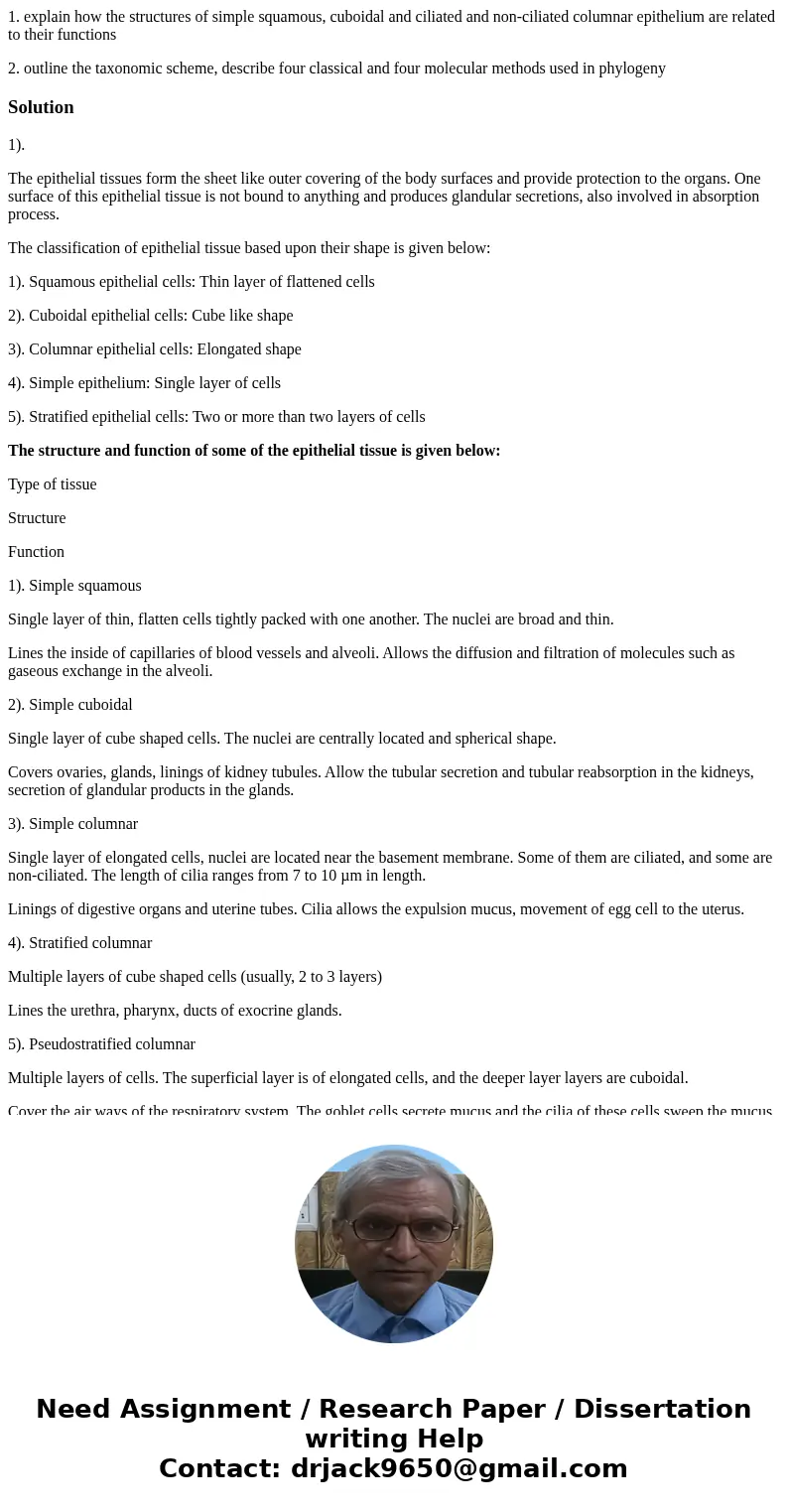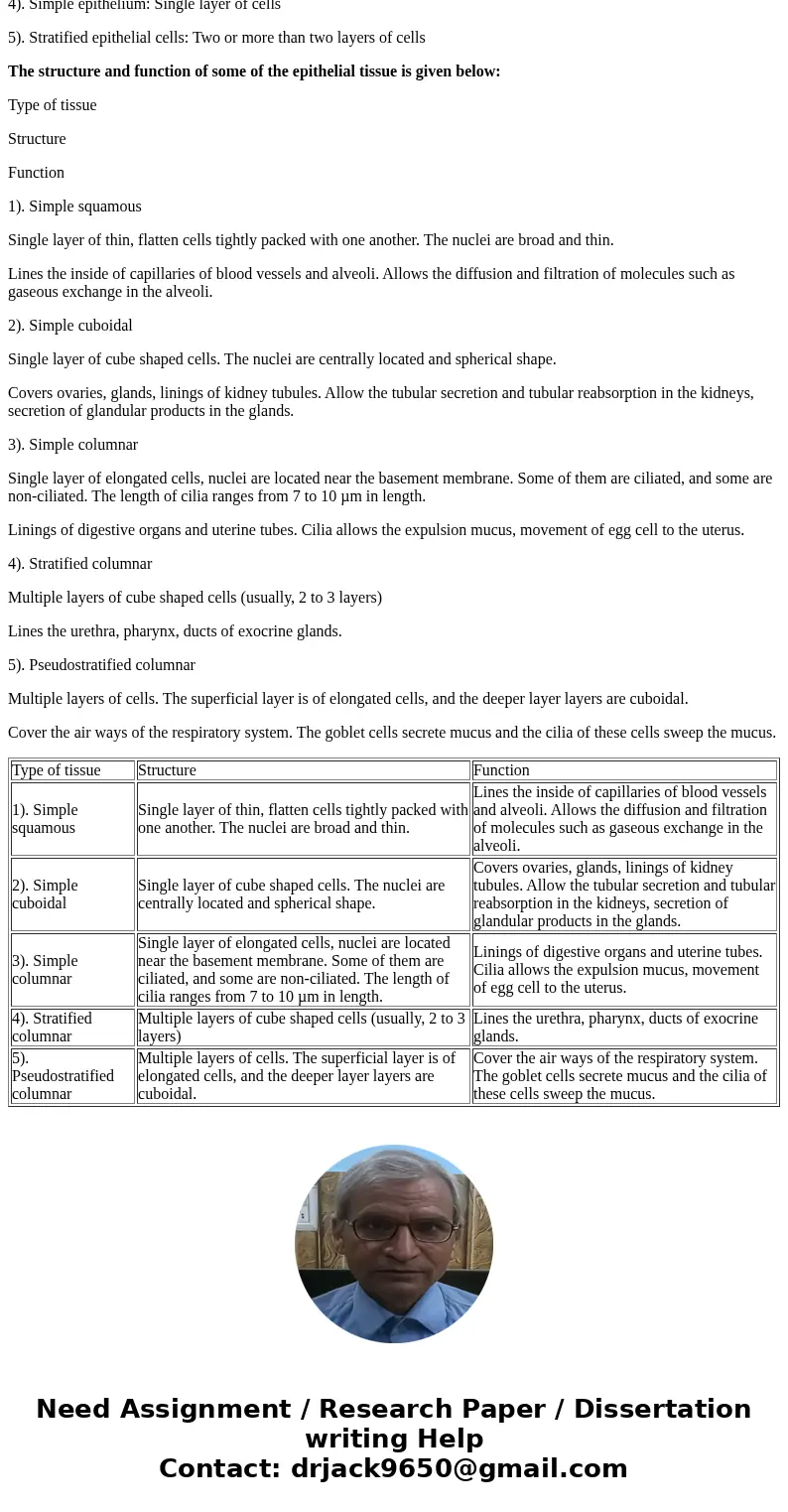1 explain how the structures of simple squamous cuboidal and
1. explain how the structures of simple squamous, cuboidal and ciliated and non-ciliated columnar epithelium are related to their functions
2. outline the taxonomic scheme, describe four classical and four molecular methods used in phylogeny
Solution
1).
The epithelial tissues form the sheet like outer covering of the body surfaces and provide protection to the organs. One surface of this epithelial tissue is not bound to anything and produces glandular secretions, also involved in absorption process.
The classification of epithelial tissue based upon their shape is given below:
1). Squamous epithelial cells: Thin layer of flattened cells
2). Cuboidal epithelial cells: Cube like shape
3). Columnar epithelial cells: Elongated shape
4). Simple epithelium: Single layer of cells
5). Stratified epithelial cells: Two or more than two layers of cells
The structure and function of some of the epithelial tissue is given below:
Type of tissue
Structure
Function
1). Simple squamous
Single layer of thin, flatten cells tightly packed with one another. The nuclei are broad and thin.
Lines the inside of capillaries of blood vessels and alveoli. Allows the diffusion and filtration of molecules such as gaseous exchange in the alveoli.
2). Simple cuboidal
Single layer of cube shaped cells. The nuclei are centrally located and spherical shape.
Covers ovaries, glands, linings of kidney tubules. Allow the tubular secretion and tubular reabsorption in the kidneys, secretion of glandular products in the glands.
3). Simple columnar
Single layer of elongated cells, nuclei are located near the basement membrane. Some of them are ciliated, and some are non-ciliated. The length of cilia ranges from 7 to 10 µm in length.
Linings of digestive organs and uterine tubes. Cilia allows the expulsion mucus, movement of egg cell to the uterus.
4). Stratified columnar
Multiple layers of cube shaped cells (usually, 2 to 3 layers)
Lines the urethra, pharynx, ducts of exocrine glands.
5). Pseudostratified columnar
Multiple layers of cells. The superficial layer is of elongated cells, and the deeper layer layers are cuboidal.
Cover the air ways of the respiratory system. The goblet cells secrete mucus and the cilia of these cells sweep the mucus.
| Type of tissue | Structure | Function |
| 1). Simple squamous | Single layer of thin, flatten cells tightly packed with one another. The nuclei are broad and thin. | Lines the inside of capillaries of blood vessels and alveoli. Allows the diffusion and filtration of molecules such as gaseous exchange in the alveoli. |
| 2). Simple cuboidal | Single layer of cube shaped cells. The nuclei are centrally located and spherical shape. | Covers ovaries, glands, linings of kidney tubules. Allow the tubular secretion and tubular reabsorption in the kidneys, secretion of glandular products in the glands. |
| 3). Simple columnar | Single layer of elongated cells, nuclei are located near the basement membrane. Some of them are ciliated, and some are non-ciliated. The length of cilia ranges from 7 to 10 µm in length. | Linings of digestive organs and uterine tubes. Cilia allows the expulsion mucus, movement of egg cell to the uterus. |
| 4). Stratified columnar | Multiple layers of cube shaped cells (usually, 2 to 3 layers) | Lines the urethra, pharynx, ducts of exocrine glands. |
| 5). Pseudostratified columnar | Multiple layers of cells. The superficial layer is of elongated cells, and the deeper layer layers are cuboidal. | Cover the air ways of the respiratory system. The goblet cells secrete mucus and the cilia of these cells sweep the mucus. |


 Homework Sourse
Homework Sourse